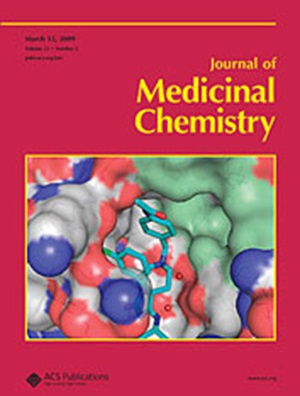Fully Synthetic TF-Based Self-Adjuvanting Vaccine Simultaneously Triggers iNKT Cells and Mincle and Protects Mice against Tumor Development
IF 6.8
1区 医学
Q1 CHEMISTRY, MEDICINAL
引用次数: 0
Abstract
The Thomsen–Friedenreich (TF) antigen has proven to be a promising target for developing novel therapeutic cancer vaccines. Here, a new strategy that TF antigen covalently coupled with KRN7000 and vizantin was developed. The resulting three-component vaccine KRN7000-TF-vizantin simultaneously triggers invariant natural killer T (iNKT) cells and macrophage-inducible C-type lectin (Mincle) signaling pathways, eliciting much stronger TF-specific immune responses than glycoprotein vaccine TF-KLH/alum and the corresponding two-component conjugate vaccines TF-KRN7000 and TF-vizantin. The analysis of IgG isotypes and the secretion of cytokines revealed that KRN7000-TF-vizantin induced Th1/Th2 mixed immune responses, where Th1 was dominant. In vivo experiments demonstrated that KRN7000-TF-vizantin increased the survival rate and survival time of tumor-challenged mice, and surviving mice rejected further tumor attacks without any additional treatment. This work demonstrates that covalently coupled KRN7000 and vizantin could serve as a promising TF-based vaccine carrier for antitumor immune therapy, and KRN7000-TF-vizantin features great potential to be a vaccine candidate.

基于全合成 TF 的自佐剂疫苗可同时触发 iNKT 细胞和 Mincle 并保护小鼠免受肿瘤发生影响
Thomsen-Friedenreich (TF)抗原已被证明是开发新型治疗性癌症疫苗的一个很有前景的靶点。在这里,我们开发了一种新策略,将 TF 抗原与 KRN7000 和 vizantin 共价结合。由此产生的三组分疫苗KRN7000-TF-vizantin能同时触发不变性自然杀伤T细胞(iNKT)和巨噬细胞诱导的C型凝集素(Mincle)信号通路,与糖蛋白疫苗TF-KLH/alum和相应的双组分共轭疫苗TF-KRN7000和TF-vizantin相比,能引起更强的TF特异性免疫反应。对 IgG 异型和细胞因子分泌的分析表明,KRN7000-TF-vizantin 可诱导 Th1/Th2 混合免疫反应,其中 Th1 占主导地位。体内实验表明,KRN7000-TF-vizantin 提高了肿瘤攻击小鼠的存活率和存活时间,存活的小鼠无需任何额外治疗即可拒绝肿瘤的进一步攻击。这项工作表明,KRN7000和vizantin共价偶联后可作为一种基于TF的疫苗载体用于抗肿瘤免疫治疗,KRN7000-TF-vizantin具有成为候选疫苗的巨大潜力。
本文章由计算机程序翻译,如有差异,请以英文原文为准。
求助全文
约1分钟内获得全文
求助全文
来源期刊

Journal of Medicinal Chemistry
医学-医药化学
CiteScore
4.00
自引率
11.00%
发文量
804
审稿时长
1.9 months
期刊介绍:
The Journal of Medicinal Chemistry is a prestigious biweekly peer-reviewed publication that focuses on the multifaceted field of medicinal chemistry. Since its inception in 1959 as the Journal of Medicinal and Pharmaceutical Chemistry, it has evolved to become a cornerstone in the dissemination of research findings related to the design, synthesis, and development of therapeutic agents.
The Journal of Medicinal Chemistry is recognized for its significant impact in the scientific community, as evidenced by its 2022 impact factor of 7.3. This metric reflects the journal's influence and the importance of its content in shaping the future of drug discovery and development. The journal serves as a vital resource for chemists, pharmacologists, and other researchers interested in the molecular mechanisms of drug action and the optimization of therapeutic compounds.
 求助内容:
求助内容: 应助结果提醒方式:
应助结果提醒方式:


